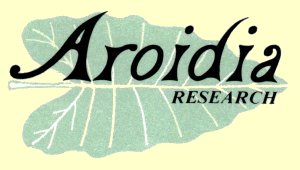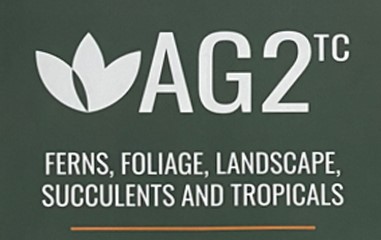
What We Are
WEBSITE STATUS - As far as I can determine, all of the Aroidia website pages are back up. As a valued visitor, you can help me - if you find a link that doesn't work, or a missing picture, please let me know so I can fix it.
Aroidia Research is a privately funded, independent effort devoted to the breeding and study of plants in the family Araceae (Aroids). I (LariAnn Garner) started this work in the late 1970s and continue to this day. Specifically, I work with Alocasia, Philodendron, Anthurium and Caladium in my hybridization efforts. Alocasias are one group of plants known commonly as "Elephant Ears"; others are Colocasia and Xanthosoma.
If you are familiar with Alocasia x calidora and Alocasia x portora (aka "calodora", "caladora", "persian palm", "portidora", "portadora", "portodora") then you should know that these two plants originated with me. These plants were two of my earliest hybrids, developed in the early 1980s when Aroidia Research was just beginning.

Special Announcement:
Recent Releases From Aroidia!
The most recent plant release is our patented hybrid, Alocasia 'Dark Star'. This plant has similarities to the so-called "blackstem" A. macrorrhizos, but in our case the plant is much larger growing, cold resistant, and easier to grow than any of the macrorrhizos types.
We have two additional hybrid plants on limited release at this time. Click 2013 New Releases to go to our page featuring the new plants. You can also see our two previously released hybrid plants; Alocasia "Robudora SuperMax" and Philodendron "Maharlika II". Click 2011 New Releases to view the 2011 New Releases page, complete with pictures and descriptions. Regrettably the 2011 New Releases are sold out and are not available in tissue culture.
NOTE: if you are a wholesale grower and wish to grow and stock some of my selected plants for your customers, please contact Mike Donn at AG2 TC for more information about obtaining young plants from them.
News and Research
The most exciting new research coming out of Aroidia is our work with xSpecialocasia vietnamensis 'Phat Chance'. This amazing plant is a natural hybrid of Leucocasia gigantea and Alocasia odora 'azurea'. See our page, xSpecialocasia for cemprehensive information on this ongoing work.
I've written over 100 articles covering aroids and other topics. The majority of them are on the Dave's Garden website (links below):
- Aroid Paradise (articles and discussion forum)
- LariAnn's article listing at Dave's Garden (Note that this list also includes some articles I did not author, but in which I am mentioned. However, most of them are ones I authored)
To learn more about what inspires me in my work at Aroidia Research, use the link below:
To view our Aroidia Research introduction video, click here!
Most Unusual Aroid award was taken home by LariAnn at the 2010 International Aroid Society Show and Sale, along with several first place finishers. The plant was a selection of a cross between Philodendron bipinnatifidum and P. goeldii. Watch for a picture of this plant soon.
Best In Show and Most Unusual Aroid! LariAnn swept top honors at the 2009 International Aroid Society Show and Sale. To see the top winners, visit 2009 IAS Show and Sale Top Honors
Feature in October 2007 issue of Ornamental Outlook! My article about the Alocasia macrorrhizos 'Borneo Giant' has been published in the October 2007 issue of OO. If you don't have access to the magazine, you may download your own PDF copy here. The PDF copy is a galley proof so the ad spaces are blocked off but not filled in. Click on Ornamental Outlook for more about this magazine.
Be sure to visit our pages showing our Caladium hybridization results, and don't forget to check our What's New page for info on our current work!
In addition to our aroid breeding programs, we have completed our first major research study, called the Alocasia Bioprotection Study, being done in conjunction with Dr. Wagner Vendrame of the University of Florida Tropical Research and Education Center in Homestead, Florida. This study included ten types of difficult to cultivate species and varieties of Alocasia and five different bioprotection products that are commercially available to growers. The objective was to define a cultural procedure for growing these plants successfully to full maturity without the need for pathogen control chemicals. The results turned out to be inconclusive because of adverse weather events which included cold and rain. This led to much higher rates of mortality unrelated to simple microbe infection.
The plants used were Alocasia robusta, A. villeneuvii, A. sanderiana, A. watsoniana 'Tiffany', A. nebula imperialis, A. rugosa, A. nebula 'Elaine', A. reversa, A. infernalis, and A. reginula 'Black Velvet'.
This bioprotection study is the first in a series of ground-breaking studies focusing on selected aroids and their growth and production. A second study that is in preliminary trials at this time is one using innovative new containers known as Superoots Air-Pots. These containers provide unequalled aeration to the root zone as well as preventing the root circling which is so prevalent in standard nursery containers.
Our Hybrids
Most of the pictured examples found here are plants actually grown at Aroidia Research. Many examples of our present accomplishments are not yet pictured on this site so as to avoid patentability issues. Seriously interested commercial parties are encouraged to contact us for more information on these newest developments. The Aroidia R & D facility is not open to the public. If you are interested in purchasing plants, please visit Obtaining our plants and/or email us.
Our Mission
Aroidia Research is dedicated to the development of new, hardier, and architecturally interesting aroid plant varieties for foliage and landscape use. Our efforts continue to produce hybrid plants that are significant improvements over what is presently available in the marketplace. Additionally, some of the work at Aroidia is oriented towards the discovery of new means and methods for growing difficult aroid plants successfully to full maturity.
All of the work at Aroidia Research is done with an eye towards the preservation of rare genetic material through incorporation into hybrids that are far more likely to survive under the rigors of 21st century conditions. Many of the most desirable aroids are also the most endangered and difficult to grow, so if this germ plasm is to be preserved over the long term, it must, in our opinion, become a part of the genetic makeup of much hardier stock.
What do we do for funding?
Our sister venture, engaged in retail and mail order sales and production of Rainbow Eucalyptus (Eucalyptus deglupta) is a source of funding for our work.
We also distribute surplus aroid plants via mail order sales directly to retail customers. For more information about this, click: Obtaining Our Plants
We are Proud Members of:
| In the Lab | In the Field | The Species | Fruiting | The Hybrids |




